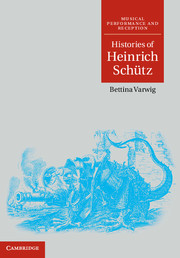Book contents
- Frontmatter
- Contents
- Abbreviations
- Music examples
- Figures
- Acknowledgments
- Introduction
- Chapter One Trumpets and drums (Psalmen Davids, 1617)
- Chapter Two Echoes, mirrors and masks (Dafne, 1627)
- Chapter Three Life, death and afterlife (Musicalische Exequien, 1636)
- Chapter Four Old and new worlds (Geistliche Chor-Music, 1648)
- Conclusion
- Chronology
- Bibliography
- Index
Introduction
Published online by Cambridge University Press: 05 November 2011
- Frontmatter
- Contents
- Abbreviations
- Music examples
- Figures
- Acknowledgments
- Introduction
- Chapter One Trumpets and drums (Psalmen Davids, 1617)
- Chapter Two Echoes, mirrors and masks (Dafne, 1627)
- Chapter Three Life, death and afterlife (Musicalische Exequien, 1636)
- Chapter Four Old and new worlds (Geistliche Chor-Music, 1648)
- Conclusion
- Chronology
- Bibliography
- Index
Summary
Clio, gesta canens, transactis tempora reddit.
AusoniusThe German word ‘Geschichte’ is an ambiguous entity, denoting both ‘story’ and ‘history’ as things that happened (‘geschehen’) once upon a time. But while these two connotations have become clearly separated over the past two centuries or so, early seventeenth-century German writers often made no such distinction. Instead, they used the term interchangeably with the Greek-derived ‘Historie’ to refer indiscriminately to stories that took place either in reality or in the imagination. History, overseen by the muse Clio, converged with poetry in its storytelling impulse and didactic intent; like a mythological tale, historical writing could instruct readers about virtues and vices through engaging narrative. The conflation of the concept's dual meanings is highlighted in the preface to a German translation of Nicolas de Montreux's hugely popular pastoral novel Schäffereyen Von der schönen Juliana (Bergeries de Juliette) of 1615. The pastoral, as the prototypical narrative mode of the sixteenth and early seventeenth centuries, enabled the representation of real-life concerns in allegorical form; hence, the editor explained, although Aristotle had outlined the virtuous life in an unadorned manner, others have ‘described this art in veiled and metaphorical ways, often in the guise of a history, because there are many who wish to read nothing but histories, be they true or invented’. From this perspective, fables, historical tales and biblical parables all shared the same truth value. Like scriptural truths, history could elucidate the past, provide exemplars for the present, and be used to speculate about the future. Human history and ancient myths were both embedded in the all-encompassing timeline of the Bible: in a comprehensive chronicle of world events published in Frankfurt in 1630, the historian and theologian Johann Ludwig Gottfried promised to ‘fuse pagan histories diligently with holy and divine history’. His account accordingly begins at the moment of Creation and adopts the traditional subdivision into four monarchies (Assyrian, Persian, Macedonian, Roman) borrowed from the biblical Book of Daniel.
- Type
- Chapter
- Information
- Histories of Heinrich Schütz , pp. 1 - 7Publisher: Cambridge University PressPrint publication year: 2011

